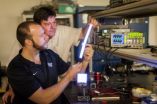(Press-News.org) CAMBRIDGE, Mass. (December 2, 2012) –Whitehead Institute scientists report that certain molecules present in high concentrations on the surfaces of many cancer cells could be exploited to funnel lethal toxic molecules into the malignant cells. In such an approach, the overexpression of specific transporters could be exploited to deliver toxic substances into cancer cells.
Although this finding emerges from the study of a single toxic molecule and the protein that it transports, Whitehead Member David Sabatini says this phenomenon could be leveraged more broadly.
"Our work suggests a different strategy for cancer therapy that takes advantage of the capacity of a cancer cell to take up something toxic that a normal cell does not," says Sabatini, who is also a professor of biology at MIT and a Howard Hughes Medical Institute (HHMI) investigator. "As a result, that toxic molecule would kill the cancer cell. By identifying transporters on the surface of cancer cells, you might be able to find a molecule that a specific transporter would carry into the cell, and that molecule would be toxic to that cell. You really could have something that's much more selective to cancer cells."
The Sabatini lab's research is published online today in the journal Nature Genetics.
Kivanc Birsoy, a postdoctoral researcher in Sabatini's lab and first author of the Nature Genetics paper, used a special line of haploid cells developed by former Whitehead Fellow Thijn Brummelkamp to screen for genes that assist cellular entry of 3-bromopyruvate's (3-BrPA), a potential cancer drug in clinical development. 3-BrPA is thought to work by inhibiting glycolysis, a cellular process that releases energy by splitting glucose molecules. Because many cancer cells are heavily dependent on the upregulation of glycolysis, drugs that interrupt this pathway may be effective in targeting these glycolytic cancer cells.
From the screen and massively parallel sequencing, Birsoy identified the gene that codes for the protein monocarboxylate transporter 1 (MCT1), which is necessary and sufficient for 3-BrPA's transport into cells, where the toxic molecule ultimately kills them. In fact, the level of MCT1 on the surface of glycolytic tumor cells is a predictor of those cells' sensitivity to 3-BrPA—the higher the cells' expression of MCT1, the more sensitive they are to 3-BrPA. This holds true in in vitro and in vivo models across multiple lines of human cancer cells.
The correlation between MCT1 concentration and 3-BrPA sensitivity could be used to help determine how certain malignant tumors are treated.
"This study makes MCT1 a biomarker for 3-BrPA," says Birsoy. "So in the future, if 3-BrPA is approved as a drug, presumably you could predict if a patient's cancer tumor is going to be sensitive by looking at the levels of this molecule. No tumor without MCT1 would respond to treatment with 3-BrPA."
###
This work was supported by the National Institutes of Health (CA103866), the David H. Koch Institute for Integrative Cancer Research, the Jane Coffin Childs Memorial Fund, and the National Science Foundation (NSF).
Written by Nicole Giese Rura
David Sabatini's primary affiliation is with Whitehead Institute for Biomedical Research, where his laboratory is located and all his research is conducted. He is also a Howard Hughes Medical Institute investigator and a professor of biology at Massachusetts Institute of Technology.
Full Citation:
"MCT1-mediated transport of a toxic molecule is an effective strategy for targeting glycolytic tumors"
Nature Genetics, December 2, 2012, online.
Kivanc Birsoy (1,2), Tim Wang (1), Richard Possemato (1,2), Omer H Yilmaz (1,2), Catherine E Koch (1,2), Walter W Chen (1,2), Amanda W Hutchins (1,2), Yetis Gultekin (1,2), Tim R Peterson (1,2), Jan E Carette (1,6), Thijn R Brummelkamp (1,6), Clary B Clish (3) and David M Sabatini (1).
1. Whitehead Institute for Biomedical Research, Cambridge, Massachusetts, USA.
2. Department of Biology, Massachusetts Institute of Technology (MIT), Cambridge, Massachusetts, USA.
3. Broad Institute, Cambridge, Massachusetts, USA.
4. David H Koch Institute for Integrative Cancer Research at MIT, Cambridge, Massachusetts, USA.
5. Howard Hughes Medical Institute, MIT, Cambridge, Massachusetts, USA.
6. Present addresses: Department of Microbiology and Immunology, Stanford University School of Medicine, Stanford, California, USA (J.E.C.) and Department of Biochemistry, Netherlands Cancer Institute, Amsterdam, The Netherlands (T.R.B.)
Cell surface transporters exploited for cancer drug delivery
2012-12-03
ELSE PRESS RELEASES FROM THIS DATE:
Surprising results from study of non-epileptic seizures
2012-12-03
MAYWOOD, Il. - A Loyola University Medical Center neurologist is reporting surprising results of a study of patients who experience both epileptic and non-epileptic seizures.
Non-epileptic seizures resemble epileptic seizures, but are not accompanied by abnormal electrical discharges. Rather, these seizures are believed to be brought on by psychological stresses.
Dr. Diane Thomas reported that 15.7 percent of hospital patients who experienced non-epileptic seizures also had epileptic seizures during the same hospital stay. Previous studies found the percentage of such ...
A better way to make chemicals?
2012-12-03
Bulk solvents, widely used in the chemical industry, pose a serious threat to human health and the environment. As a result, there is growing interest in avoiding their use by relying on "mechanochemistry" – an energy-efficient alternative that uses high-frequency milling to drive reactions. Because milling involves the intense impact of steel balls in rapidly moving jars, however, the underlying chemistry is difficult to observe.
Now, for the first time, scientists have studied a milling reaction in real time, using highly penetrating X-rays to observe the surprisingly ...
Glowing fish shed light on metabolism
2012-12-03
A tiny, translucent zebrafish that glows green when its liver makes glucose has helped an international team of researchers identify a compound that regulates whole-body metabolism and appears to protect obese mice from signs of metabolic disorders.
Led by scientists at the University of California, San Francisco (UCSF), the work demonstrates how a fish smaller than a grain of rice can help screen for drugs to help control obesity, type 2 diabetes and other metabolic disorders, which affect a rising 34 percent of American adults and are major risk factors for cardiovascular ...
Stanford researchers discover master regulator of skin development
2012-12-03
STANFORD, Calif. — The surface of your skin, called the epidermis, is a complex mixture of many different cell types — each with a very specific job. The production, or differentiation, of such a sophisticated tissue requires an immense amount of coordination at the cellular level, and glitches in the process can have disastrous consequences. Now, researchers at the Stanford University School of Medicine have identified a master regulator of this differentiation process.
"Disorders of epidermal differentiation, from skin cancer to eczema, will affect roughly one-half ...
International study points to inflammation as a cause of plaque buildup in heart vessels
2012-12-03
STANFORD, Calif. — Fifteen new genetic regions associated with coronary artery disease have been identified by a large, international consortium of scientists — including researchers at the Stanford University School of Medicine — taking a significant step forward in understanding the root causes of this deadly disease. The new research brings the total number of validated genetic links with heart disease discovered through genome-wide association studies to 46.
Coronary artery disease is the process by which plaque builds up in the wall of heart vessels, eventually leading ...
Goodbye, fluorescent light bulbs! See your office in a new light
2012-12-03
Say goodbye to that annoying buzz created by overhead fluorescent light bulbs in your office. Scientists at Wake Forest University have developed a flicker-free, shatterproof alternative for large-scale lighting.
The lighting, based on field-induced polymer electroluminescent (FIPEL) technology, also gives off soft, white light – not the yellowish glint from fluorescents or bluish tinge from LEDs.
"People often complain that fluorescent lights bother their eyes, and the hum from the fluorescent tubes irritates anyone sitting at a desk underneath them," said David Carroll, ...
Common diabetes drug may help treat ovarian cancer
2012-12-03
A new study suggests that the common diabetes medication metformin may be considered for use in the prevention or treatment of ovarian cancer. Published early online in CANCER, a peer-reviewed journal of the American Cancer Society, the study found that ovarian cancer patients who took the drug tended to live longer than patients who did not take it.
New treatments are desperately needed for ovarian cancer. Previous research has indicated that metformin, which originates from the French Lilac plant, may have anticancer properties. To look for an effect of the medication ...
Food allergies? Pesticides in tap water might be to blame
2012-12-03
ARLINGTON HEIGHTS, Ill. (December 3, 2012) – Food allergies are on the rise, affecting 15 million Americans. And according to a new study published in the December issue of Annals of Allergy, Asthma and Immunology, the scientific journal of the American College of Allergy, Asthma and Immunology (ACAAI), pesticides and tap water could be partially to blame.
The study reported that high levels of dichlorophenols, a chemical used in pesticides and to chlorinate water, when found in the human body, are associated with food allergies.
"Our research shows that high levels ...
Mayo study: Common diabetes drug may treat ovarian cancer
2012-12-03
ROCHESTER, Minn. -- Diabetic patients with ovarian cancer who took the drug metformin for their diabetes had a better survival rate than patients who did not take it, a study headed by Mayo Clinic shows. The findings, published early online in the journal Cancer, may play an important role for researchers as they study the use of existing medications to treat different or new diseases.
Metformin is a widely prescribed drug to treat diabetes, and previous research by others has shown its promise for other cancers. The Mayo-led study adds ovarian cancer to the list.
Researchers ...
Increases in personal income important for happiness worldwide, new study says
2012-12-03
WASHINGTON – For people living in both rich and poor countries, the average person's happiness is based on a combination of individual wealth, possessions and optimism, according to an analysis of new worldwide survey findings published by the American Psychological Association.
A country's gross domestic product per capita did not have as much of an impact on the average person's happiness, according to research based on responses of 806,526 people in 135 countries from 2005 to 2011. Happiness expert and psychologist Edward Diener, PhD, of the University of Illinois, ...


